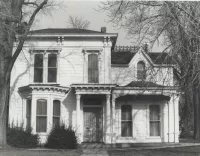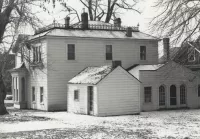Share what you know,
and discover more.
Share what you know,
and discover more.
Jul 07, 1983

-

- Charmaine Bantugan
National Register of Historic Places - Frederick Meyer House
Statement of Significant: The Frederick Meyer House, built in 1873, is significant as one of the best examples of the Italianate architectural style in Utah architecture, and as the best example of one of three major house types used to express this important nineteenth century style. Utah's Italianate, following a national trend for such houses, is found in three distinct forms: the large cross-wing house; the two-story side passageway box; and the one-story cottage. The Meyer House is the best example of the two-story box type, and is one of only two frame examples of the type in Salt Lake City. The other is the Jonathan C. and Eliza K. Royle House, 635 East 100 South, listed in the National Register, 1983. Frederick Meyer, a Mormon convert from Germany, was a salesman and eventually manager in the ZCMI clothing department. The Italianate style was made popular in the United States primarily by house pattern books, and became a common stylistic choice in Utah by the 1870s. There was great variation in the local expression of the style. Some houses, like the Albert Kelly House, 418 South 200 West, were simplified versions built for popular consumption in which only the basic form and the brackets on the cornice betray an Italianate aesthetic. At the other end of the spectrum is the Meyer House which displays all of the Italianate elements associated with Utah's expression of the Italianate style. It includes the box form and side hall plan; the low hip roof with overhanging eaves; the wide cornice decorated with both paired and single wooden brackets; the projecting bays; the long, narrow double hung sash windows; and the classical detailing of the porch over the main entrance, of the window headers, of the projecting bay, and of the corners of the building. Of eight documented extant examples of the Italianate, two story box type house in Utah, the Meyer House is one of the oldest, and is the most architecturally distinctive, a fact borne out by its recording in 1968 by the Historic American Building Survey. It is one of three such Italianate houses which is eligible for nomination to the National Register.2 The William Morrow House, 390 Quince Street, the oldest example of the type, was listed in the National Register in 1982 as part of the Capitol Hill Historic District, Salt Lake City. Other Utah examples of the Italianate style listed in the National Register include: the Charles R. Savage House, 80 D Street (cross-wing type), and the Howe C. Wallace House, 474 Second Avenue (cottage type), in the Avenues Historic District, Salt Lake City; the Lewis S. Hills House, 126 South 200 West (cross-wing type), Salt Lake City; and the David McDonald House, 4659 Highland Drive (cross-wing type), Salt Lake City. Frederick A. Eugelbert Meyer and his wife, Emelia C. Hannibal Meyer, had these two stories, Italianate house built about 1873 and moved here from 51 East Temple (Main) Street. Frederick was a salesman in the Z.C.M.I. clothing department, where he had started working the previous year and where he continued to work until his retirement in 1909, serving as manager of that department from 1891 on.
National Register of Historic Places - Frederick Meyer House
Statement of Significant: The Frederick Meyer House, built in 1873, is significant as one of the best examples of the Italianate architectural style in Utah architecture, and as the best example of one of three major house types used to express this important nineteenth century style. Utah's Italianate, following a national trend for such houses, is found in three distinct forms: the large cross-wing house; the two-story side passageway box; and the one-story cottage. The Meyer House is the best example of the two-story box type, and is one of only two frame examples of the type in Salt Lake City. The other is the Jonathan C. and Eliza K. Royle House, 635 East 100 South, listed in the National Register, 1983. Frederick Meyer, a Mormon convert from Germany, was a salesman and eventually manager in the ZCMI clothing department. The Italianate style was made popular in the United States primarily by house pattern books, and became a common stylistic choice in Utah by the 1870s. There was great variation in the local expression of the style. Some houses, like the Albert Kelly House, 418 South 200 West, were simplified versions built for popular consumption in which only the basic form and the brackets on the cornice betray an Italianate aesthetic. At the other end of the spectrum is the Meyer House which displays all of the Italianate elements associated with Utah's expression of the Italianate style. It includes the box form and side hall plan; the low hip roof with overhanging eaves; the wide cornice decorated with both paired and single wooden brackets; the projecting bays; the long, narrow double hung sash windows; and the classical detailing of the porch over the main entrance, of the window headers, of the projecting bay, and of the corners of the building. Of eight documented extant examples of the Italianate, two story box type house in Utah, the Meyer House is one of the oldest, and is the most architecturally distinctive, a fact borne out by its recording in 1968 by the Historic American Building Survey. It is one of three such Italianate houses which is eligible for nomination to the National Register.2 The William Morrow House, 390 Quince Street, the oldest example of the type, was listed in the National Register in 1982 as part of the Capitol Hill Historic District, Salt Lake City. Other Utah examples of the Italianate style listed in the National Register include: the Charles R. Savage House, 80 D Street (cross-wing type), and the Howe C. Wallace House, 474 Second Avenue (cottage type), in the Avenues Historic District, Salt Lake City; the Lewis S. Hills House, 126 South 200 West (cross-wing type), Salt Lake City; and the David McDonald House, 4659 Highland Drive (cross-wing type), Salt Lake City. Frederick A. Eugelbert Meyer and his wife, Emelia C. Hannibal Meyer, had these two stories, Italianate house built about 1873 and moved here from 51 East Temple (Main) Street. Frederick was a salesman in the Z.C.M.I. clothing department, where he had started working the previous year and where he continued to work until his retirement in 1909, serving as manager of that department from 1891 on.
Jul 07, 1983
National Register of Historic Places - Frederick Meyer House
Statement of Significant:The Frederick Meyer House, built in 1873, is significant as one of the best examples of the Italianate architectural style in Utah architecture, and as the best example of one of three major house types used to express this important nineteenth century style. Utah's Italianate, following a national trend for such houses, is found in three distinct forms: the large cross-wing house; the two-story side passageway box; and the one-story cottage. The Meyer House is the best example of the two-story box type, and is one of only two frame examples of the type in Salt Lake City. The other is the Jonathan C. and Eliza K. Royle House, 635 East 100 South, listed in the National Register, 1983. Frederick Meyer, a Mormon convert from Germany, was a salesman and eventually manager in the ZCMI clothing department. The Italianate style was made popular in the United States primarily by house pattern books, and became a common stylistic choice in Utah by the 1870s. There was great variation in the local expression of the style. Some houses, like the Albert Kelly House, 418 South 200 West, were simplified versions built for popular consumption in which only the basic form and the brackets on the cornice betray an Italianate aesthetic. At the other end of the spectrum is the Meyer House which displays all of the Italianate elements associated with Utah's expression of the Italianate style. It includes the box form and side hall plan; the low hip roof with overhanging eaves; the wide cornice decorated with both paired and single wooden brackets; the projecting bays; the long, narrow double hung sash windows; and the classical detailing of the porch over the main entrance, of the window headers, of the projecting bay, and of the corners of the building. Of eight documented extant examples of the Italianate, two story box type house in Utah, the Meyer House is one of the oldest, and is the most architecturally distinctive, a fact borne out by its recording in 1968 by the Historic American Building Survey. It is one of three such Italianate houses which is eligible for nomination to the National Register.2 The William Morrow House, 390 Quince Street, the oldest example of the type, was listed in the National Register in 1982 as part of the Capitol Hill Historic District, Salt Lake City. Other Utah examples of the Italianate style listed in the National Register include: the Charles R. Savage House, 80 D Street (cross-wing type), and the Howe C. Wallace House, 474 Second Avenue (cottage type), in the Avenues Historic District, Salt Lake City; the Lewis S. Hills House, 126 South 200 West (cross-wing type), Salt Lake City; and the David McDonald House, 4659 Highland Drive (cross-wing type), Salt Lake City.
Frederick A. Eugelbert Meyer and his wife, Emelia C. Hannibal Meyer, had these two stories, Italianate house built about 1873 and moved here from 51 East Temple (Main) Street. Frederick was a salesman in the Z.C.M.I. clothing department, where he had started working the previous year and where he continued to work until his retirement in 1909, serving as manager of that department from 1891 on.
Posted Date
Jun 30, 2023
Historical Record Date
Jul 07, 1983
Source Name
National Register of Historic Places
Source Website
Delete Story
Are you sure you want to delete this story?











